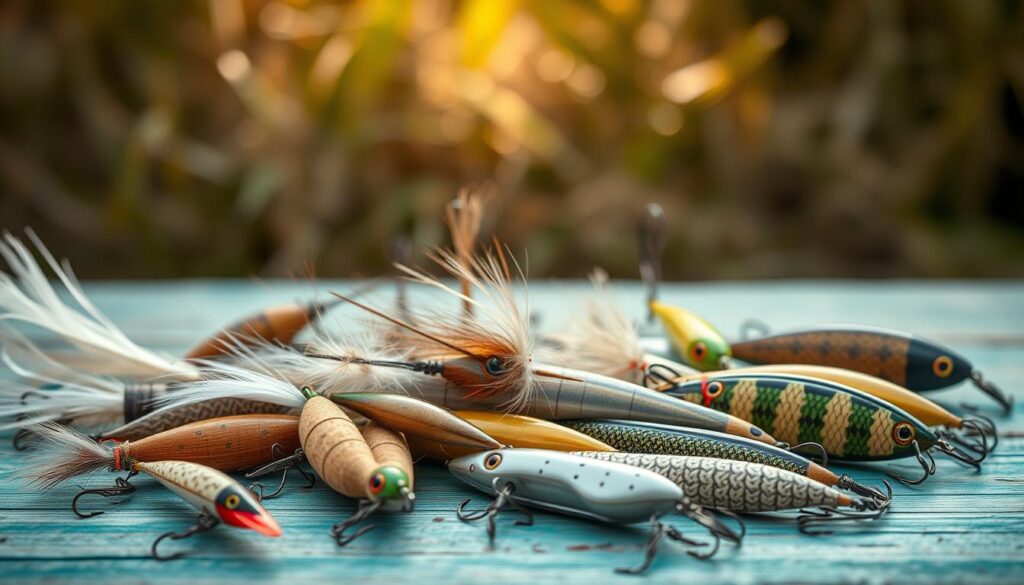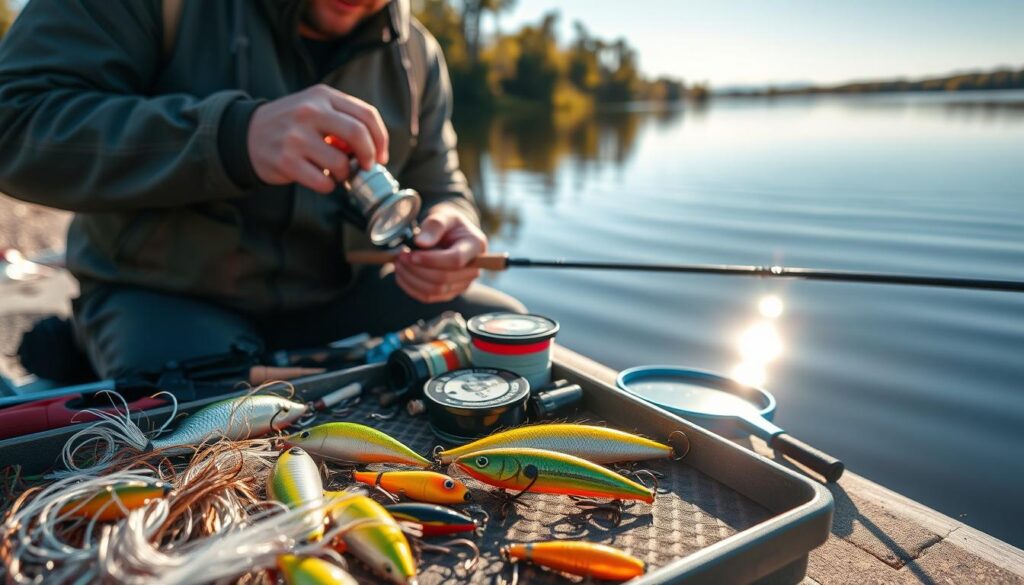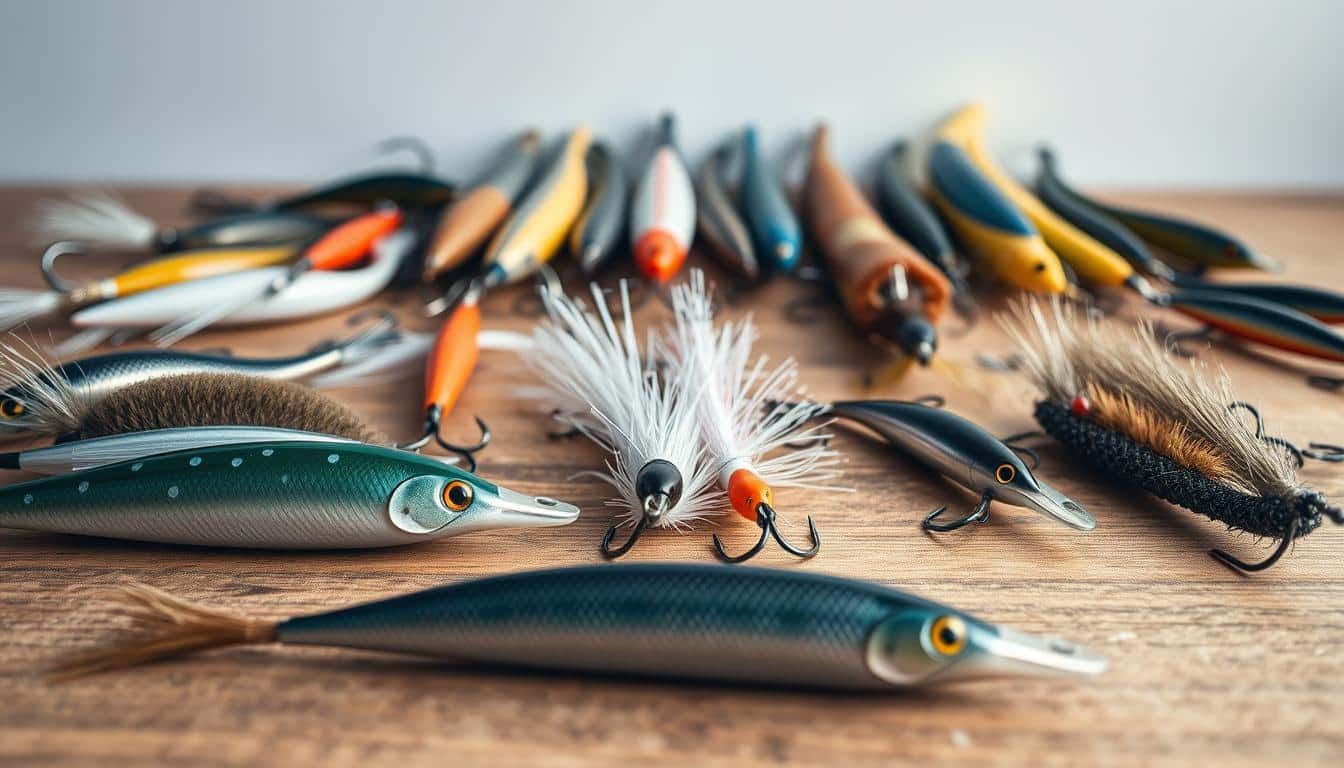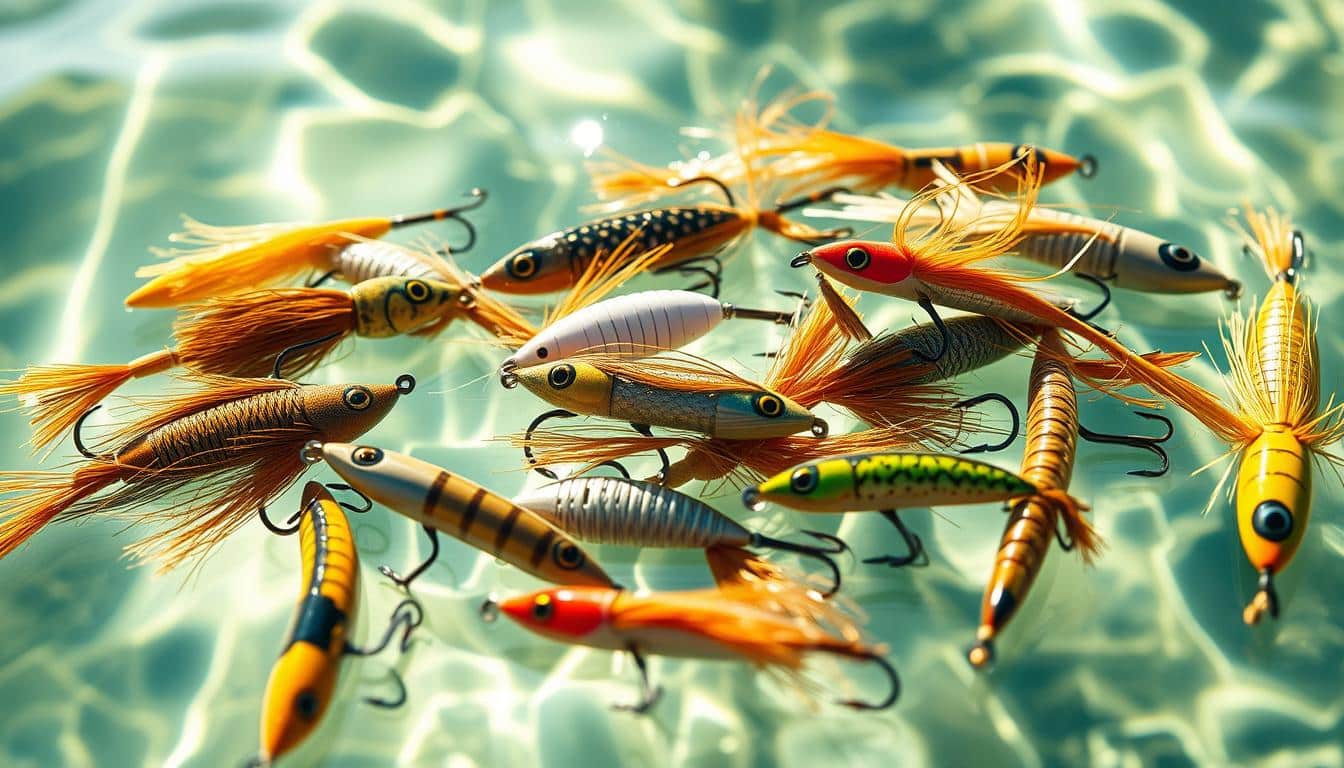This article looks at biodegradable and plastic-free fishing lures for US anglers. We want to help you understand their benefits and environmental effects. This helps you pick the best eco-friendly bait for your style of fishing.
Fishing gear often ends up polluting our waters, seen during clean-ups. A recent examination of a sperm whale in Florida found bits of fishing lines and plastics in its belly. This shows the damage from lost fishing gear. It’s a good reason to think about using biodegradable lures.
There have been attempts at creating biodegradable fishing lines in the past. For example, Bioline, from 2008 to 2010, claimed it would break down in less than five years. However, it didn’t last due to corporate changes and low sales. Nowadays, Tuf Line offers a biodegradable line that says it can break down in about seven years.
Some have experimented with hemp-PLA blends for lures. Jenko introduced a hemp version of their Groovy Glide in 2021. Also, small businesses like Bea’s Bait Shack are making hemp PLA100 Doo-Bs with fish oil. These tests show potential but also the challenges of durability and decomposing time.
Another approach is to not use new plastics at all. For example, Alternative Fishing Lures in Florida makes lures from plastics found in ocean waste. These materials are 100% recycled and don’t use lead. This is different from lures made of wood, metal, or natural fibers, which don’t use any plastic.
We’ll go over the choices, explain the claims and certifications, and offer tips on picking the right type of eco-friendly tackle. If you’re worried about the harm from lost fishing gear, this guide is for you. It’ll help you find fishing tackle that is good for the environment and works well.
Biodegradable vs Fully Plastic-Free Lures Explained
This comparison clearly defines products and trade-offs. It helps anglers pick gear that balances catching fish with caring for the environment. Think of this as a useful part of your guide to eco-friendly fishing gear.
What this comparison covers
We compare biodegradable lures and fully plastic-free lures. Biodegradable lures break down under specific conditions. Plastic-free lures use materials like wood, metal, or hemp instead of plastic.
Look for examples like Tuf Line and BioBait for biodegradable choices. For hybrid and plastic-free options, we mention hemp PLA lures and Ecoluremaker DIY kits. Alternative Fishing Lures are noted for using recycled plastic.
We talk about how these lures perform in water, their smell, how tough they are, and how long they last. Our goal? To give you a fair look at both kinds of lures. This way, you can set the right expectations for your fishing trips.
Why the distinction matters for anglers and marine life
The material of your fishing gear affects the planet. Biodegradable products need certain conditions to break down and take time to do so. Fully plastic-free options avoid synthetic materials, cutting down on microplastic pollution.
Anglers must pick between gear that lasts and gear that’s safer for the ocean. Studies showing animals hurt by fishing gear underline why choosing the right kind of lure matters for both fishing success and protecting nature.
How to use this guide to choose sustainable lures
Be smart about picking your fishing lures. Look at what companies say and what tests show. Choose lures that suit the fish you’re after and the way you fish to lose less gear.
- Look at certifications and test results to judge if something really is biodegradable.
- Use fishing methods that help prevent losing your lures.
- Think about if you can get and fix plastic-free lures locally.
Use this as a handy guide within a larger handbook on eco-friendly fishing gear. It helps you pick lures that are better for our planet, still meeting your needs as an angler.
Why fishing tackle pollution is a problem for waterways and marine animals
Fishing tackle pollution harms coastal and inland waters more than most anglers realize. Lost fishing lines, hooks, and gear pile up over time. During cleanups, many lines, lures, and net pieces are found, highlighting this issue’s severity.
Scale and sources of pollution from fishing gear
Anglers use monofilament, fluorocarbon, and braided lines. These can get stuck on reefs and seafloors and often get left behind. Lost crab traps and nets turn into ghost nets, trapping animals long after they’re lost.
Local fishers, hobby anglers, and big fishing companies all play a part. Gear gets worn out, lost in storms, or thrown away improperly. This sends lots of small plastic pieces from rivers to the ocean.
Examples of harm: entanglement and ingestion
Entanglement happens when animals get caught in fishing gear. Sea turtles, seabirds, and marine mammals need help when they’re hurt by this debris. They can get injured, infected, and even starve because of it.
When animals eat fishing gear, it’s often found during studies after they die. Whales and dolphins have been found with bits of gear inside them, linking lost fishing gear to serious internal harm. Seabirds often eat small lures by mistake, thinking they’re food.
Longevity of common plastics and environmental persistence
Fishing line can last up to 600 years in nature. This means it stays in our oceans and on our beaches for centuries.
Braided lines and those made from polyester and nylon break down very slowly. They turn into microplastics, which spread throughout the marine food chain. This causes ongoing harm to marine life due to fishing gear.
What makes a lure biodegradable: materials and breakdown conditions
To understand what makes a lure biodegradable, anglers need to consider the materials, how they’re made, and the environment where the lure ends up. These factors influence how fast a lure will break down. Always read labels and seek out solid test data when a product says it’s biodegradable.
Common biodegradable materials used in lures
- Soft baits and parts molded by injection often use biopolymers like polylactic acid, known as PLA. PLA needs certain conditions to decompose.
- PLA hemp bioplastic blends mix PLA with hemp to make stronger, less fossil-based products. Shops like Bea’s Bait Shack test these blends for effective use while cutting down on plastics.
- Some brands create modified rubbers that break up and get eaten by microbes quicker than usual rubber. They focus on alternatives to cut-bait with water-soluble or enzyme-activated rubbers.
- Biodegradable fishing plastics sometimes use water-soluble ingredients or starch-based fillers. How well these work can vary a lot.
Environmental conditions required for biodegradation
Biodegradation needs certain things like warmth, air, tiny life forms, and moisture. Places like industrial compost facilities provide the right conditions for fast breakdown. But cold lakes and oceans, or places without air like some landfills, do not.
It takes longer for things to biodegrade in the ocean. Materials might vanish quickly in tests but last years in saltwater. In freshwater, how long something takes to decompose can change with the season and water depth.
Limitations and claims to watch for
- Only trust claims of biodegradability if they give specific timelines based on tests. Vague claims aren’t very reliable.
- Look for proof from third parties. Standards to trust include ASTM and ISO tests for marine environments or compostability; brands like Biobait and Tuf Line should show their test results.
- Be careful with blanket statements. A lure marked as compostable might only break down in industrial setups, not in the water.
- When companies describe their products, they might not all use the same terms. Compare details, like whether it’s PLA hemp bioplastic or just a generic “plant-based plastic,” to understand what to expect.
What fully plastic-free lures are: true alternatives and materials
Fully plastic-free lures avoid synthetic stuff and lean on old but improved materials. Anglers wanting less plastic waste have choices like wooden plugs, metal spoons, and plant fiber ties. These alternatives try to keep the fishing fun without using oil-based plastics.

Non-plastic materials commonly used
- Wood lures coated with marine varnish to stand up to water.
- Metal lures made from stainless steel or brass that sparkle in water.
- Gear made from natural fibers like hemp for eco-friendly fishing.
- Soft lures from plant materials that don’t rely on traditional plastics.
Durability and performance compared to synthetic lures
Wood and metal lures last longer and perform reliably. They resist wear and catch fish well.
Metal jigs resist damage and make fish bite hard.
Natural fiber gear and hemp lures need extra care but work great for certain fish. They wear out faster and might not stretch or smell like plastic lures.
Baiting methods and handling notes
- Wood lures are perfect for hook attachments and work best on the water’s surface.
- Metal jigs need careful setup to move right in the water.
- Keeping natural gear dry and treated helps it last longer.
Supply and market availability in the United States
Shops that honor fishing traditions sell these plastic-free choices. Hemp lure options in the USA are growing but still somewhat rare.
Wood and metal lures are easier to find from many sellers. However, natural fiber gear is more likely found at specialized stores. If you’re searching for hemp lures in the USA, checking out local or online specialty shops is the way to go.
Biodegradable lure brands and product examples with real-world notes
This section shares info on eco-friendly fishing products. It includes what makers claim and what anglers say about their experience.
Major commercial lines
- Tuf Line biodegradable monofilament comes in various strengths. It’s said to last five years unopened and biodegrades in seven. Fishers find it easy to use but want more tests.
- Biobait and BioBait pop up in boxes and stores, known for lasting fish-oil smell. Reviews praise its scent and durability but remind us to check biodegradation claims closely.
Small makers and DIY kits
- Bea’s Bait Shack offers lures made from hemp and fish oil. They’re locally crafted, offering a natural option. Their life and breakdown depend on the environment.
- Ecoluremaker’s kits let you make your own eco-friendly lures. You can customize the scent and color. However, how well they degrade may vary.
Recycled-plastic alternatives from recovered marine debris
- Alternative Fishing Lures makes lures from plastics found in oceans. Their products are 100% recycled, helping reduce new plastic use and clean oceans.
Practical buyer notes
- Always check for detailed tests and results on biodegradability.
- Choose lures that fit how you fish. Some eco-friendly ones might behave differently.
- Using a mix of eco-friendly and recycled lures can minimize your impact without sacrificing quality.
Both small businesses and large companies offer green fishing solutions. DIY kits from Ecoluremaker are great for those who like to experiment. Ready-to-use products from brands like Tuf Line and Biobait are convenient. Recycled lures help tackle marine pollution.
Performance trade-offs: durability, scent retention, action, and angler experience
Anglers choosing between biodegradables and traditional plastics consider their durability, scent, and movement in the water. Results from tests by groups like MONSTERBASS and companies such as BioBait and Tuf Line are varied. Some eco-friendly baits are as tough as normal ones and work well with different fishing rigs. Yet, others might not last as long as those made from materials like PVC or silicone.
How biodegradable plastics compare for tear resistance and shelf life
Biodegradable lures vary in how tough they are and how long they last. BioBait, for example, has shown to resist tears well in tests, especially with wacky and drop-shot rigs. Tuf Line claims a five-year shelf life for some of its products, if not opened.
Though made to last, biodegradable products can change in texture over time. Bioline once advertised a five-year shelf life, but had to adjust their claims due to product changes. It’s important for buyers to check when the product was made and how to store it properly.
Scent-infused and fish-oil–infused biodegradable baits: pros and cons
Scented biodegradable baits offer a consistent smell and stay soft thanks to the fish oil. People like Jeff Burlingame at MONSTERBASS note that BioBait gives off a strong yet not overwhelming scent, and it doesn’t lose its smell quickly, even after many uses.
- Pros: they attract more fish, keep their smell longer, and are softer, which can lead to more bites.
- Cons: adding scents can make storage harder, involve more rules on labels, and might upset some anglers.
Whether fishermen use scented biodegradable lures might depend on laws and personal likes, especially in competitions or just for fun.
Rigging, sinking rate, and action differences between biodegradable and traditional plastics
Comparing their movement, biodegradable worms and flukes often sink slower and move more lively. BioBait’s designs, meant to sink slowly, have a strong tail movement that’s great for EWG and drop-shot setups.
Setting them up is usually the same. Most biodegradable baits fit wacky, Texas, and Carolina rigs without changes. How they hold a hook and their stiffness can vary, so it’s a good idea for anglers to test them with the fish they’re aiming for, to see if they perform well under strong pulls.
Environmental certification, testing, and greenwashing risks
Anglers need clear labels and real test data to evaluate eco claims on fishing lures. Retail packaging and websites might use friendly words without details on performance in saltwater, freshwater, or industrial composting. It’s better to look for specific details rather than catchy slogans to decide if a product really meets biodegradability standards.
What credible biodegradability testing looks like
Trustworthy reports are from well-known labs using standards like ASTM or ISO. A reliable marine test will note the salinity, temperature, oxygen levels, and time until the product starts to break down. Tests for compostability have their own set of requirements for temperature and time.
Manufacturers should clearly say which test they used and share the results or a certification number.
Red flags to watch for
Be wary when you see “biodegradable” with no extra details. Claims missing info about the polymer or test conditions are not very helpful. If a company is only showing ads without third-party proof, be skeptical. The failure of promising products in the past warns us that unsupported claims are risky for shoppers.
How to evaluate manufacturer transparency and labeling
Ask for lab reports and check if the eco claim fits for saltwater, freshwater, or composting. Look for labels that tell you about the material’s origin, where it was made, and who certified it. Brands such as BioBait sharing test summaries and how they make their products are more reliable.
When a retailer can’t give testing details upon request, think about other options. Consider items that are recycled or completely free of plastic.
- Request the test method and timescale before purchase.
- Prefer third-party verification over internal lab claims.
- Compare whether the claim addresses compostable vs marine biodegradable conditions.
- Be alert for greenwashing in tackle when claims lack documentation.
Practical tips for anglers to reduce tackle-related pollution today
Small adjustments in fishing can have a big impact on our waters. Follow these tips to keep your fishing gear in top shape and prevent loss. Choose methods that work well in your fishing area and with your preferred equipment.

- Check knots before every cast and retie if frayed. Good knots cut downtime and reduce lost tackle.
- Use shock leaders or heavier tippet when targeting toothy species to prevent sudden line failure.
- Trim tag ends and secure split rings and swivels with thread or a dab of nail polish to stop slippage.
- When snagged, try a controlled back-and-forth or use a forceps to free hooks instead of cutting the line.
- Replace damaged line proactively; aged monofilament and braided lines weaken without obvious wear signs.
Choosing lures: biodegradable, recycled, or fully plastic-free
Choose biodegradable lures for areas where lost lures could harm the environment. Look for ones with proven breakdown claims.
Recycled-plastic lures are a good alternative, reducing new plastic use while keeping lure action. They use ghost-net materials.
For a plastic-free option, consider wood, metal, or natural-fiber lures. They work well and avoid synthetic materials. Think about action, durability, and your fishing spot when picking sustainable tackle.
How to store, dispose, and recycle fishing tackle responsibly
- Keep scented biodegradable baits in sealed containers and follow the temperature advice to last longer.
- Put broken lines, lures, and leaders in a tackle bin, not left behind.
- Recycle line and lead at tackle shops offering take-back programs. Look for Berkley or Plano-style options.
- For responsible lure disposal, separate metal, wood, and recyclable plastics for proper recycling.
- Support community cleanups. Giving found gear to research or recycling helps more.
Combine good line management with careful gear choices. These steps lower tackle loss now and encourage choosing sustainable tackle in the future.
Community and industry actions improving sustainable tackle options
Anglers, volunteers, and small businesses are making a difference in tackle production and disposal. They regularly clean shores and reefs, collecting lost fishing gear. This data helps focus cleanup efforts in areas that need it most.
Cleanup efforts and data gathered by anglers and volunteers
Volunteer groups, including fishing clubs and Sea Shepherd, help clean beaches and underwater areas. They find and log items like old nets and fishing lines. This logging helps identify the spots that need the most attention.
These cleanups reveal that gear often gets lost around marinas and popular fishing spots. This information encourages local authorities to install better disposal stations. It also supports efforts to clean up these areas more efficiently.
Industry experiments and discontinued attempts
Early attempts at creating eco-friendly products learned the hard way. For example, the Bioline product, which was supposed to break down quickly, faced skepticism after changes in company ownership led to its removal from the market.
Experiments, like Toray’s Field Mate, showed the challenges of balancing product durability with environmental safety. These examples stress the need for thorough testing and clear information for consumers before launching such products.
Opportunities for innovation: demand signals, recycled ghost net programs, and local makers
More consumers want eco-friendly fishing gear, seen in subscription boxes and stores offering such options. This interest is encouraging companies to innovate with sustainable products.
- Recycling programs turn old nets into new items, highlighting the benefits of reusing materials.
- Local crafters and workshops offer sustainable alternatives like hemp-based bait, needing clearer standards to grow bigger.
- Collaborations between NGOs, brands, and marinas are creating recycling programs that support the use of recycled plastics in new fishing lines.
Anglers, scientists, and companies working together are finding new ways to make fishing gear that’s good for both fishing and the ocean. By conducting practical tests and keeping up with cleanups, they gather essential data. This helps develop products that are not only effective but also environmentally responsible.
Cost, availability, and where to buy eco-friendly lures in the United States
At first, it seems hard to figure out sustainable tackle. Prices, how much is in stock, and checking claims can change a lot. This guide helps you understand costs, where to find products, and how to check on local makers. So, you can buy with sureness.
Price comparisons
- Eco-friendly soft baits cost more than regular plastic ones because they use special materials and are made in small batches.
- Recycled plastic lures and those made of wood or metal also cost more. This is due to the work and materials needed.
- Prices vary: there are cheap eco-friendly lines under $10, recycled lures between $10 and $25, and handmade ones for over $25.
Retail sources and subscription services
- Shops like Bea’s Bait Shack have special eco-friendly items. They can tell you about the materials and where they come from.
- Buying direct from the maker’s website lets you look at the details. You can check if the lures are made in the USA.
- Boxes like MONSTERBASS include different eco-friendly lures, good for trying out new ones.
- Brands that use recycled materials tell you where to find their products. They are in local stores and online.
How to find and verify local producers
- Look online with specific words like hemp PLA lures to find small makers.
- Check if the product info is clear and ask the seller for more details if it’s not.
- Choose small businesses that are clear about their products. Check their claims about eco-friendly materials are true.
- If you’re not sure, talk to the seller directly. Good sellers share proof their products are eco-friendly.
Quick buying checklist
- Think about price and how long the lure will last compared to plastic ones.
- Check for clear material names and if they’ve been tested.
- Find out about returns and if you can try out lures in subscription boxes.
- Choose sellers with good reputations when looking for eco-friendly options in the USA.
Conclusion
Biodegradable lures break down under certain conditions, but the time varies. They’re different from plastic-free lures, which use natural materials like wood and metal. Choose based on what matters for the environment and your fishing needs. It’s also crucial to look for products with clear labels and third-party tests.
Anglers should check if biodegradability claims have marine-specific tests. Consider lures made from recycled plastics, such as those from old fishing nets, for a quick positive impact. Also, try out new baits to see if they work well with your fishing gear and techniques. Paying attention to how you fish can lessen the chance of losing gear, helping the environment even more.
When looking for eco-friendly lures, ask for data from manufacturers. Support local businesses and programs that use recycled materials. Getting involved in local cleanups can also make a big difference. The best choice, whether it’s biodegradable, recycled, or completely plastic-free, depends on your style of fishing and the place you fish in.
FAQ
What is the difference between biodegradable and fully plastic-free lures?
Why does this distinction matter for anglers and marine life?
What does this guide cover to help me choose sustainable tackle?
How big is the problem of fishing-tackle pollution?
What evidence links lost tackle to harm in marine animals?
How long do common synthetic fishing materials persist in the environment?
What materials are commonly used to make biodegradable lures?
Do biodegradable lures actually break down in the ocean or freshwater?
What claims and limitations should I watch for on biodegradability labels?
What materials make up fully plastic-free lures?
How do plastic-free lures perform compared with synthetic plastics?
Are fully plastic-free lures readily available in the U.S.?
Which biodegradable lure brands and products are on the market now?
What about recycled-plastic alternatives?
How do biodegradable plastics compare for tear resistance, scent retention, and shelf life?
What are the pros and cons of scent-infused, fish-oil–based biodegradable baits?
Do biodegradable lures rig and fish the same as traditional plastics?
What constitutes credible biodegradability testing?
How can I evaluate manufacturer transparency and labeling?
What are practical steps anglers can take right now to reduce tackle-related pollution?
When should I choose biodegradable, recycled, or fully plastic-free lures?
How should I store and dispose of biodegradable and scented baits?
What cleanup and industry efforts are helping improve sustainable tackle options?
Have there been notable discontinued biodegradable products and what can we learn?
Are eco-friendly lures more expensive, and where can I buy them?
How can I find and verify local producers of sustainable lures?
Content created with the help of Artificial Intelligence.



